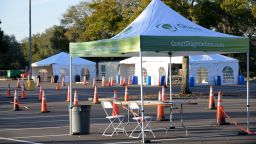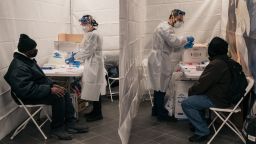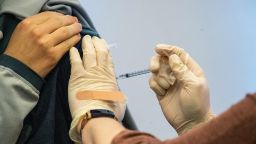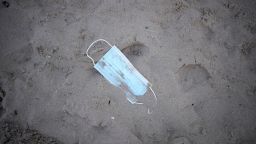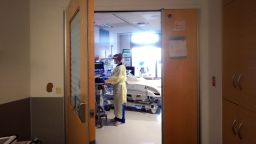From the very beginning of his presidency, Joe Biden has pledged to make sure communities hit hardest by Covid-19 will receive sound information about the virus and access to vaccinations.
“Equity (and) equality” remain “at the heart” of the government’s responsibility, Biden said at a White House briefing last summer. “We need to go to community by community, neighborhood by neighborhood, and oftentimes, door to door – literally knocking on doors.”
But some of the small groups representing communities of color that were contracted as part of a National Institutes of Health Covid-19 outreach project tell CNN they have not been paid properly.
“We lost trust in the system,” said Venus Ginés, president of Día de la Mujer Latina, who said the NIH effort has been “poorly managed from the beginning” and “poorly executed.”
“It’s a very lousy system, not set up for community engagement, but no matter how much we talk about it and there are apologies for it, there is no attempt to reform it,” said Ysabel Duron, executive director of the Latino Cancer Institute in California. “For me, the system has to change.”
Under that system, community groups such as Día de la Mujer Latina and the Latino Cancer Institute front money for their NIH projects and get paid back later.
Ginés said participating in the NIH program cost her organization $64,000 in unreimbursed invoices, which the NIH denies.
She said other costs were reimbursed many months late. Duron and the leader of a third community group also said it took months to reimburse tens of thousands of dollars in expenditures, which put a huge stress on their small operating budgets.
Dr. George Mensah, an NIH official, told CNN that many community organizations have been involved with his agency’s effort, called the Community Engagement Alliance Against COVID-19 Disparities or CEAL, and he has heard directly about problems with only one of them, Día de la Mujer Latina.
He said NIH’s “strategic partnerships” with community-based organizations – the “boots on the ground” – play a “critical role” in “building confidence in the vaccine [and] conveying essential messages around prevention, so we take them very, very seriously.”
Mensah said NIH is “committed to resolving” the challenges small community-based organizations have had with CEAL and is “fully, fully committed” to making sure that the community groups are compensated “promptly” and “fairly.”
At the center of the issue is the reimbursement model NIH used for the contracts with the community groups. Several of these groups told CNN that while they were aware they wouldn’t be paid up front, it has been a huge financial strain to spend tens of thousands of dollars of their own money and then wait – sometimes for many months – to get paid back.
Mensah said NIH recognizes that small community groups are not like large academic centers and “are not able to go out and do the work and wait to be paid later.”
People involved with CEAL say they told NIH in the first half of 2021 there were problems with this payment system, but that NIH did not explain until last month that faster payment methods were possible.
Birth of an unprecedented NIH effort
In the spring and summer of 2020, federal officials realized they needed to work on two Covid-19 problems in communities of color – and fast.
First, the virus was hitting these communities hard, with disproportionately more hospitalizations and deaths than White people.
Second, NIH and the pharmaceutical company Moderna were having trouble recruiting people of color into clinical trials for the Covid-19 vaccine.
Typically, when the NIH sets out to address a health problem, it works with large organizations such as universities or pharmaceutical companies. But in 2020, agency officials spoke often about the need to do something different – they needed to engage trusted messengers in small grassroots groups.
That’s how CEAL was born in September 2020. Since then, more than $48 million has been spent on the program, according to NIH.
“Never before has NIH been involved in a community engagement effort of this magnitude,” Mensah, director of the Center for Translation Research and Implementation Science at the NIH’s National Heart, Lung, and Blood Institute told CNN, noting that “the size, the scale, scope and speed with which we’ve responded [to] communities in greatest need has been unprecedented.”
NIH at that time reached out to universities in 11 states and asked them to seek out grassroots, community-based groups to work on the project.
One of those universities, the University of North Texas Health Science Center at Fort Worth, reached out to Día de la Mujer Latina, the health advocacy group that Ginés, a breast cancer survivor, started 25 years ago in Texas. While the group is small, with just two full-time employees, it’s well-known, and Ginés was honored for her work at a White House event in 2009.
Ginés said her group was approved for a $230,000 budget for a CEAL project, which included expanding a telephone hotline where bilingual promotores de salud, or community health workers, answer questions about Covid-19, logging thousands of calls a month.
“COVID-19 Hotline Beats Misinformation One Call at a Time,” proclaimed a headline on a May 2021 article on NIH’s CEAL website.
Ginés says while the NIH was touting the hotline’s success, her invoices to CEAL to pay the promotores were not being reimbursed.

NIH is accustomed to working with large organizations that have financial and government contracts departments experienced at working out the nitty-gritty details of complicated NIH contracts and accounting requirements.
But Día de la Mujer Latina doesn’t have anything close to that kind of staffing – the only full-time employees are Ginés and an administrator. When Ginés asked the university for reimbursement for her work on CEAL, she says she spent months submitting and resubmitting invoices and waiting for payments.
While other community leaders told CNN they believe bureaucratic issues are at the root of CEAL’s reimbursement issues, Ginés said for her, the entire experience adds up to “systemic racism.”
“Universities create metrics that are inherently biased when allocating budget funding to community partners,” Ginés wrote to CNN in an email. “These practices are rooted in upholding systemic barriers that privilege larger institutions over smaller, grassroots ones. We call this a subtle form of structural racism and discrimination.”
The “COVID-19 pandemic exposed a deep-rooted under-investment and under-valuing of community- based organizations (CBOs) especially Community Health Workers/Promotores who are the footsoldiers combating COVID-19, vaccine hesitancy, and misinformation,” she added.
When asked about that charge, Mensah said NIH valued its partnerships with community groups and that “remunerating them (is) very, very important to us.”
Jamboor Vishwanatha, the principal researcher for the Texas CEAL program, said he valued the “tremendous contribution” made by Día de la Mujer Latina to CEAL.
The university and Día de la Mujer Latina communicated “in an effort to detail invoicing instructions, outline the required Subrecipient Monitoring Form, and a request for [Día de la Mujer Latina] to update its budget to be in compliance with the NIH Uniform Guidance. This back and forth continued over several months,” Laken Rapier wrote in an email to CNN in January, when she was associate vice president at the University of North Texas Health Science Center.
Ginés says she felt frustrated with both the university and NIH as she struggled to pay the promotores who were working the hotline phones.
“We felt that the government really spoke from both sides of their mouth,” Ginés said, meaning that the NIH emphasized the value of engaging with community groups, but did not ensure these groups were paid promptly for their work.
To form the CEAL team, NIH has contracted with universities in 21 states, Puerto Rico and the District of Columbia, which in turn have made subcontracts with community organizations.
Luis Torres-Hostos, a CEAL project lead at the University of Texas Rio Grande Valley, said the community groups he’s worked with on CEAL “live paycheck to paycheck” and have had to “wait and wait and wait” to get their payments.
“The community-based organizations are critical. We can’t do this work without them, so we’ve got to figure out a way to get money to them faster,” Torres-Hostos said. “There’s going to be another health crisis, and if we don’t learn lessons from this [CEAL] project, we’re going to be in deep trouble next time.”
A researcher at a university in Arizona that’s participating in CEAL told CNN that the community groups he subcontracted with email “constantly” to ask when they will be paid. The researcher asked to be anonymous because they were not authorized to speak to the media about sensitive internal matters.
“This is not an environment that’s good for these small community organizations to work in. They can’t wait six or seven months to get paid,” the researcher said, adding that the community groups “understand the needs of the community and their voice is essential in projects like these, but if we can’t get them paid in time, then going forward, they’re not going to trust us enough to partner with us anymore.”
NIH referred specific questions about CEAL community-based organizations to universities.
“NIH’s awards management relationship is with the primary recipient of NIH funding, not with the recipient of subawards made by the prime awardee,” NIH spokeswoman Hillary Wicai Archer wrote to CNN. “Given the nature of government funding, NIH can only speak to the funding that its administrative center awarded to principal investigators of the 21 CEAL teams at their academic institutions.”
‘We’re depending on the big guy to pay us’
In addition to Día de la Mujer Latina, other community-based organizations involved with CEAL also said they struggled, waiting months to get reimbursed for tens of thousands of dollars in expenses for the work they did.
Duron, director of the Latino Cancer Institute in San Jose, California, said her group fronted about $16,200 for CEAL work starting in October 2020, doing media cultural sensitivity training seminars related to Covid-19, and didn’t receive a reimbursement for six months. She said other reimbursements also took months.
“We’re depending on the big guy to pay us,” she said, adding that it created a “snowball problem” as she sometimes couldn’t pay her workers on time or had to use money from other grants to pay her workers.
She said her small organization – she’s the only full-time employee – struggled to keep up with the complicated requirements to get reimbursed.
“They were throwing paperwork at me like I was a multimillion dollar vending company,” she added. “We don’t have huge financial offices. We don’t have multi millions of dollars in business with you. If you want the community to be able to work with you, you have to make adjustments.”
Duron received her CEAL contract through UCLA.
“The Latino Cancer Institute has been paid in full, consistent with our agreement. We understand the concern and apologize for the inconvenience related to timing,” according to a statement from the David Geffen School of Medicine at UCLA. “While we received the first invoice from the Latino Cancer Institute in December 2020, we were unable to disperse payment until the contract was completed and signed in March 2021. Two subsequent invoices were paid promptly after receipt of invoices. We thank the Latino Cancer Institute for the thoughtful and valuable services provided.”
The leader of a community group in another state said when they started working on a CEAL project to do Covid-19 outreach and education, they were not allowed to submit invoices for three months.
While a three-month wait might not be much of an issue for a large company or a university, it was a major financial problem for this small community organization, the leader said, asking to speak anonymously “to avoid any possible retaliation or retribution.”
“I literally just wanted to help,” the leader said, but “[the university officials] were fierce.”
She said once the three months were over, her small organization – it has no full-time employees – submitted and resubmitted invoices only to have them sent back to her because they failed to follow some rule or another. She said for one invoice to be paid, it took nearly 30 emails between her and about five different people.
“At one point they basically said, ‘If [you] can’t figure it out, we can’t accept the invoice.”
Torres-Hostos, a professor and founding dean of the school of social work at the University of Texas Rio Grande Valley, said he worked out payment issues with this community leader and thought it was resolved.
“We made sure that the right people met with her and explained the process and the forms and how to fill them out, and once that was done, it was smooth sailing,” he said.
The community leader said the process was not smooth, but after about four months, her group was paid in full.
Complaints to federal officials
These problems came to a head in June of 2021, when Ginés sent an email to Mensah at the NIH.
She wrote that CEAL had “missed opportunities” for universities “to fully support community stakeholders who often execute the lion’s share of the important work of reaching and intervening with distressed populations to bring about improved health outcomes and health responses in communities.”
Mensah said he took Ginés’ complaints “very seriously” and called her within an hour of receiving her email.
He receives a lot of email, “but an email like that we act on immediately,” he told CNN.
Ginés told CNN that in that conversation, she asked Mensah to allow payments to be made in advance to community groups, instead of using the reimbursement model.
The day after Ginés sent her email, another NIH official, Erynn Hunt, wrote to her that “we are distressed to hear that members of the CEAL coalition of community-based organizations and health workers are not receiving payments and are working to better understand the issues.”
Mensah said as far as he knew, the issue with Ginés had since been resolved.
But Ginés told CNN that CEAL did not compensate her for $64,000 of what she spent on her CEAL work.
Vishwanatha, the principal investigator on the UNT CEAL grant, disputed this, and said Ginés overspent her budget for the first six months of the project.
Two months later, after speaking with Ginés, the leader of a nonprofit group reached out to a White House official.
“How are we to expect community orgs to jump through hoops such as this while they have been called upon during a global emergency to educate and facilitate vaccination among our most vulnerable populations?” Amy Pisani, CEO of Vaccinate Your Family, wrote to Dr. Bechara Choucair, then the White House Covid-19 vaccinations coordinator.
A source involved with the situation said Choucair sent a response the next day and forwarded Pisani’s email to officials at the US Department of Health and Human Services, which oversees NIH, for follow up. The source asked to be anonymous because they were not authorized to speak to the media about internal department communications.
‘In our community, it’s all about trust’
Community groups weren’t the only ones complaining last year to NIH officials about the payment structure to community groups.
Vishwanatha, the principal investigator for the Texas CEAL team, said a few months after the program started in September 2020, CEAL researchers and NIH officials started discussing the difficulties during regular weekly calls and asked whether there were alternative ways to pay the community groups.
“All of us – all the CEAL teams – we are all in agreement that something needs to be done,” he said, referring to CEAL contractors at other universities. “There’s no question about that.”
But Mensah, the NIH official, told CNN last month he was unaware that universities had asked about alternative payment methods.
Vishwanatha, a molecular geneticist and director of the Texas Center for Health Disparities, told CNN it was his understanding from discussions with NIH officials that the agency required that the contracts be made on a reimbursement basis, and payments could not be made up front.
“This is a contractual mechanism where you do the work, you get paid. There is no down payment here,” he said. “The governmental procedures – there’s not much you can do. You have to go through all of these rules and requirements.”
Torres-Hostos, the researcher at the University of Texas Rio Grande Valley, said he had the same understanding.
“I didn’t even think it was possible” to pay community groups up front, he said.
But it turns out that for months, CEAL teams in several other states had been making payments up front.
Lisa Hamilton Jones, who runs a community group in Florida, said the University of Miami approached her in the fall of 2020 about a CEAL contract to do Covid-19 community education. But she said when she found out it would be on a reimbursement basis, she declined, and the university then agreed to make some of the money available in advance.
Jones said she had no financial issues with her CEAL contract, worth about $45,000.
“I ended up having the opposite experience as other community organizations,” said Jones, the co-president of the Florida Community Health Workers Coalition.
CNN first approached the NIH about this story last fall. Last month, an agency spokeswoman informed CNN that it was possible for universities to have prepayment arrangements, and included a list of several CEAL teams with such arrangements.
“Through preliminary data recently obtained through the CEAL review process which began last summer, we have learned that several of the CEAL funded universities have alternative approaches to ensure timely payment to community-based organizations,” Archer, the NIH spokeswoman, wrote to CNN. “CEAL is currently engaged in sharing these alternative payment models and processes with all 21 teams so that they can learn from each other’s promising practices.”
Get CNN Health's weekly newsletter
Sign up here to get The Results Are In with Dr. Sanjay Gupta every Tuesday from the CNN Health team.
She added that “NIH is committed to ensuring that (community-based organizations), critically important partners in the fight against COVID-19, are paid on time” and that “NIH is committed to providing resources to its prime awardees to assist them in ensuring their subawardees (community-based organizations) are appropriately remunerated. When any challenge has come to NIH’s attention, our business office has stepped in when appropriate and worked with awardees to ensure full payment.”
Archer added that “it’s important to remember that we are in the middle of a pandemic” and NIH is a “learning organization” that is “taking the time to review processes, understand what is working, [and] identify and address challenges.”
Rapier, the official at the University of North Texas, said her university did not learn about these alternative payment possibilities until a meeting on February 18. Vishwanatha said that for the next year of funding, he proposed to NIH paying the community organizations 20% of their money up front.
The community leaders interviewed by CNN questioned why the NIH hadn’t mentioned the possibility of using alternative payment approaches when the program started a year and a half ago.
“What happened with the money – it’s like a symbol – you want my participation, but it feels like every step of the way you guys don’t want to make it easy to participate,” said Duron, the community leader in California.
Said Ginés of Día de la Mujer Latina, “They lost my trust. And in our community, it’s all about trust.”




















